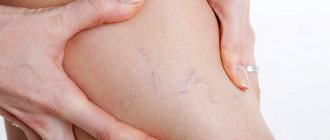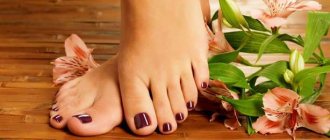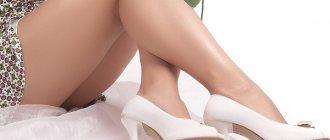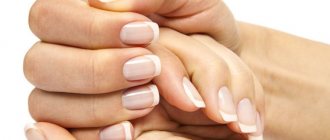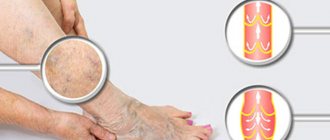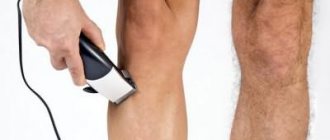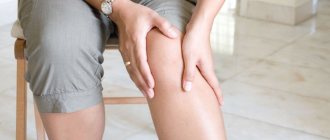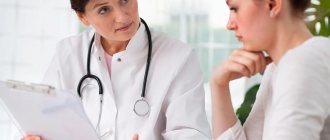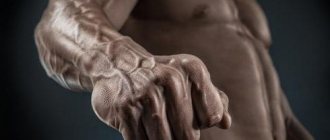What does the appearance of green veins on the legs indicate?
The most common reason that blood vessels can be seen with the naked eye on the skin of the legs is varicose veins.
Varicose veins are associated with an increase in the diameter of blood vessels and a change in the structure of the venous wall. At advanced stages of varicose veins development, green veins can not only be seen, but also palpated. Normally, venous vessels are located more superficial to the skin than arterial vessels. But subcutaneous fat and skin usually do not “see through” the vessels.
If a person’s skin is thin and the fat layer is poorly expressed, then vessels throughout the body may be visible: veins on the arms, legs, as well as capillaries on the face, etc. In this case, the vessels cannot be palpated, since they are of normal diameter and are simply located too close to the skin.
In addition, sometimes a person can see that green veins have appeared in some area after active physical activity. In cases where they go away on their own after rest, this symptom can be considered physiological. In this regard, visible green veins on the legs do not always indicate pathology.
But if visible vessels appear suddenly and do not go away even after rest, you should make an appointment with a phlebologist.
Why are veins visible on my legs? Reasons for appearance
Having discovered that the veins in the legs have become very visible, the first thing we do is look for the cause of this manifestation and think about what to do next? There are a lot of factors influencing the appearance of a venous pattern and the enlargement of veins. Let's start with the fact that such symptoms occur not only in adult women and men, but can also occur in a child (from an infant to a teenager). Therefore, the reasons will vary depending on the patient’s gender and age.
Often in children, veins are visible in the legs in the popliteal fossa. The reason is most often an anatomical feature or, which is the norm, a local decrease in the thickness of the subcutaneous fat layer before the age of 1 year. At the same time, one should not exclude the possibility that this may be a pathology of the venous system. In adolescents 12-15 years old, dilated veins in the popliteal region may appear due to physical inactivity or excessive physical activity.
Why are veins visible on the legs of a young girl and woman? Between the ages of 16 and 20, the body undergoes hormonal changes. In addition, girls have an increased interest in high-heeled shoes. All this can cause the appearance of telangiectasias and reticular veins throughout the lower limb - they can cover both the lower leg and the thigh. Women during pregnancy and, especially after childbirth, may develop varicose veins, in which not only a distinct blue venous pattern appears, but also varicose veins appear, pain and heaviness appear in the lower extremities, swelling and cramps often occur, especially in the at night or in the evening.
Why do men have visible veins in their legs? Contrary to misconceptions, the circulatory system in men is also susceptible to vascular pathologies, like women’s. Therefore, the reason why blue convoluted veins became visible on a man’s legs is varicose veins. At the same time, increased physical activity, for example, long workouts in the gym, lifting weights and squats with a heavy barbell, has a negative effect on the veins. In bodybuilding, for example, changes in the venous system invariably occur due to special exercises and nutritional supplements. The desire to enhance the venous pattern can sometimes lead to the development of varicose veins. If the veins are not palpable, but simply visible under the skin, then there is most likely no cause for great concern. These are just closely spaced veins that we see due to a small amount of subcutaneous fat; this does not pose any threat to health.
In general, under the influence of many reasons, including the lack of a proper daily routine, adequate nutrition and the presence of bad habits, the functioning of the valves on the walls of the veins can be disrupted, which directly affects the entire mechanism of venous blood circulation. Some reasons will lead directly to the development of varicose veins and other vascular pathologies, while others will be a temporary physiological reaction to certain internal and external stimuli/processes that do not entail negative consequences.
Expert opinion
According to medical statistics, 90% of patients over 40 years of age who consult a doctor with complaints that veins and capillaries are visible on their legs are diagnosed with varicose veins and other vascular diseases.
Vascular surgeon, phlebologist
Osipova Ekaterina Yakovlevna
What to do and what to do if you discover an increased venous pattern, we will tell you further.
Visible veins in the legs: methods of struggle
But there are cases when you should consult a doctor
Above, we recalled the most common reasons for the appearance of visible veins, which are not dangerous to human health and should not bother him. But sometimes this sign may indicate the presence of serious illnesses and is a reason to immediately visit a doctor. The first thing to remember: in such cases, the appearance of visible veins on the body is not the only warning symptom. The patient may also experience chest pain, shortness of breath, ulcers near the veins or swelling of the veins.
Under no circumstances should unpleasant symptoms be left unattended, as they may be associated with health problems: varicose veins, thrombophlebitis and other venous diseases. An experienced specialist will conduct a diagnosis and help determine the exact cause of the problem, and then prescribe treatment that can get rid of the disease.
What causes varicose veins?
Various factors can provoke problems with veins, from lifestyle and life to various processes occurring in the body. What exactly became the basis for the development of the disease is important to know in order to choose subsequent treatment. Considering the most common reasons, we can highlight:
- Intense physical activity, prolonged standing.
- Uncomfortable shoes, prolonged wearing of heels.
- Overweight.
- Hormonal changes. It is these reasons that can provoke pathology in young people, for example, when veins are visible on the legs of a teenager.
- Genetic predisposition.
- A sedentary lifestyle, including staying in one position, which is typical for office workers.
- Bad habits, unhealthy diet.
Enlarged veins can occur as a complication from other chronic diseases or as a side effect from overwork, but in any case, this problem should not be ignored. The sooner measures are taken, the greater the chance of preventing complications in the form of closure of the lumen of the veins, thrombophlebitis and other dangerous pathologies.
Veins become more noticeable during pregnancy
Visible veins are a problem that many pregnant women face. But, as in previous cases, there is nothing to worry about. The blood volume of a pregnant woman is higher than that of a non-pregnant woman. Veins have to adapt to the changed operating conditions of the body. During this period of time, the blood vessels need to work at an increased pace in order to transport an increased volume of blood throughout the woman’s body and, in addition, to the fetus growing inside her. If visible veins appeared during pregnancy, although they were not so visible before, they will most likely “disappear” soon after childbirth, that is, they will become less noticeable.
Causes of bulging veins
Protruding veins in the legs can be a marker of various diseases and occur due to the influence of provoking factors. The latter include high physical activity. If after a hard workout a vein pops out in your leg, there is no need to panic: carry out relaxing procedures and notice the changes:
- became invisible - everything is normal;
- remains visible - contact a medical institution to get advice and prevent the development of dangerous diseases.
If veins are visible in the legs, the most likely cause is varicose veins. It develops as a result of metabolic disorders, weakening of the thin walls of blood vessels, which have a multilayer structure: endothelium, muscle tissue and connective fibers. They provoke pathology and disruption of the valves that regulate blood flow.
Varicose veins of the lower extremities can result from:
- sedentary lifestyle;
- work that requires standing for a long time (doctors, salespeople) and heavy lifting (loaders, etc.);
- bad habits;
- excess weight;
- diabetes mellitus;
- wearing tight and uncomfortable clothes;
- prolonged increased intra-abdominal pressure;
- unfavorable environmental conditions (excessive gas pollution in large cities, the content of heavy metals in the air and other harmful impurities that have a negative impact on the human hematopoietic system).
Pregnancy should not be discounted: during this period, women undergo body restructuring and the load on their legs increases (due to the growing fetus). Here it is important not to miss the manifestation of the first symptoms (small vessels appear under the skin), promptly inform the doctor about the changes and begin gentle treatment.
These are not all the causes of the disease, in which the veins protrude on the legs. Scientists have proven that if there were people in the family suffering from the pathology in question, then it can manifest itself at any time.
How can green veins on the legs be dangerous?
If you can see large, tortuous, green veins on the skin, this means that they are not fulfilling their function. Enlarged varicose veins are unable to adequately move blood from the legs to the heart.
In addition to the cosmetic defect, the situation is complicated by many other symptoms of venous insufficiency: fatigue, heaviness, swelling and pain in the legs. Heaviness in the legs is especially pronounced in the evening. These symptoms gradually intensify and bring great discomfort.
Often, fatigue and pain in the legs are so severe that they significantly reduce the patient’s quality of life. And complications of varicose veins (thrombophlebitis, deep vein thrombosis, etc.) are potentially fatal conditions. Therefore, you should not postpone treatment of the disease until later.
Are therapeutic methods for treating leg veins effective?
When veins become visible on the legs, as well as itching and swelling, it is rare to consult a specialist. More often, the patient thinks that he has very thin skin and only moisturizes it, which will not bring visible results. More progressive people change their lifestyle, begin to move more actively, play sports, perform massages and exercise therapy. Another part of the patients, when veins in the legs become visible, resort to traditional methods of therapy, and also prepare ointments, rubs and compresses. Others go to the pharmacy and buy creams, among which are:
Varius
All of these methods are effective against emerging spider veins or at a minor stage of the disease, but there is a possibility of blockage of the vein, which requires an appropriate response.
Prevention
To ensure that the veins do not come out on the leg, but remain in their place, it is necessary to engage in prevention.
This becomes especially relevant for those people in whose lives there are certain provoking factors. Especially if it is not possible to eliminate them for certain reasons (for example, sedentary work).
Prevention of varicose veins involves maintaining a healthy lifestyle
- quitting smoking and alcohol;
- forget the habit of crossing your legs;
- regular walking;
- passion for any kind of sport (swimming and cycling are welcome);
- refusal to visit the bathhouse;
- choosing comfortable shoes;
- arrange a contrast shower for your feet;
- start eating right;
- in the evening, try to lie down for a while so that your legs are on a slight elevation.
Such simple rules will help preserve the beauty of your legs and avoid various pathological conditions associated with the vascular system.
Complications and prevention of bulging veins
If protruding veins are not treated, you can expect the development of thrombosis, thrombophlebitis, phlebitis, and even death (if a blood clot breaks off and enters the pulmonary artery).
Measures to prevent the development of such an unpleasant disease as bulging veins in the legs are:
- Carrying out gentle gymnastic exercises (there is a set of special exercises).
- Eating foods rich in essential vitamins (A, E, C).
- If you have a sedentary lifestyle, periodically change positions (rest every hour for 10-15 minutes) to avoid stagnation of blood in the legs.
- Competent selection of shoes (with low heels, made from natural materials, comfortable).
- Thorough foot care (rinsing with cool water, massage, baths, etc.).
Read also: Laser treatment of varicose veins in Angarsk reviews
Exercises to prevent bulging veins
A basic set of exercises looks like this:
- Take a sitting position on a chair with a straight back, feet pressed to the floor. Alternately raise and lower your heels and then your toes. Repeat 15-20 times on each leg.
- The starting position is identical, perform smooth rolls from toe to heel and back. For greater effect, it is possible to use special massagers in this exercise (you can place a roll of a towel or a small bottle of water under your feet).
- The starting position is the same, alternately lifting the legs followed by circular movements in the ankle area. Repeat 10-15 times on each leg.
- The person stands upright, with a straight back, hands on his belt. In this position, you need to lift on your toes. You can overcome difficulties by leaning your hands on the wall. Repeat 15-20 times.
Are the veins on your legs very visible? Do not delay your visit to a phlebologist and remember: any disease is easier to treat in the initial stages, and early contact with a specialist will help you quickly cope with the problem. Take care of your feet and stay healthy by following simple recommendations.
How to cure green veins on legs?
If the cause of the appearance of visible blood vessels on the skin is varicose veins, then it is worth starting treatment as early as possible. Varicose veins can be cured using Laser and Radiofrequency technology, as well as Miniphlebectomy.
Laser and radiofrequency techniques affect the vessel from the inside. To do this, a catheter is inserted into the vein cavity. Through it, the doctor exerts a thermal effect on the veins of the legs. Miniphlebectomy is based on the removal of green veins on the legs through small accesses.
In cases where green veins are small in diameter, doctors may recommend Sclerotherapy. Sclerotherapy is a non-surgical method for removing minor vascular pathologies (for example: varicose veins on the legs). All of these methods comply with European safety standards and are carried out without anesthesia or skin incisions.
Vein expansion in adults
When an adult suddenly and dramatically has veins protruding all over his body, there is justifiable concern. However, this phenomenon does not always indicate a disease. Sometimes veins appear as a result of prolonged physical activity or as a sign of natural age-related changes. But in this case, they should not cause any discomfort other than aesthetic ones. Signs such as:
- feeling of heaviness in the limbs;
- aching pain during exercise;
- the surface of the protruding vessels is uneven, bumpy;
- swelling in the area of the affected limbs;
- muscle weakness;
- poor, prolonged wound healing;
- formation of ulcers;
- change in skin color in the affected area.
If the dilation of veins is due to obstruction of blood flow, the reason may be hidden in the formation of blood clots on the walls of blood vessels. In this case, it is necessary to remove formations, which otherwise could cause blockage of blood vessels and local cessation of blood flow.
The inflammatory process that occurs in the cavity of the veins and affects their walls is called phlebitis. This phenomenon occurs as a complication of varicose veins, or as a consequence of internal infectious processes in the body. In both cases, pathogenic microflora forms a focus of inflammation, destroying the venous walls. Phlebitis of the superficial veins can cause veins throughout the body to become very visible. This disease has many forms, each of which requires immediate treatment as it can lead to serious complications.
For example, one of the most dangerous forms of phlebitis, thrombophlebitis, often leads to death. This happens because the process of inflammation of the venous wall is accompanied by the formation of a blood clot in the vascular lumen, which, due to tearing off, can move through the bloodstream and clog, for example, an artery of the respiratory system. In this case, sudden death occurs. Even if this does not happen, a blood clot wandering through the circulatory system will sooner or later provoke a blockage of the main vein. And this in turn will lead to the development of venous insufficiency.
Meanwhile, with timely consultation with a doctor and appropriate treatment, this disease is easy to eliminate. First, the patient is prescribed a detailed diagnosis to determine the condition of all blood vessels in the body, after which a course of antibacterial drugs that suppress the inflammatory process is prescribed. Additional therapeutic procedures may also be required.
Cosmetic phlebology - addresses and prices
Cosmetic phlebology in Moscow
Cosmetic phlebology in the Moscow region
Cosmetic phlebology in St. Petersburg
Cosmetic phlebology in Vladivostok
Cosmetic phlebology in Volgograd
Cosmetic phlebology in Voronezh
Cosmetic phlebology in Yekaterinburg
Cosmetic phlebology in Izhevsk
Cosmetic phlebology in Irkutsk
Cosmetic phlebology in Kazan
Cosmetic phlebology in Kemerovo
Cosmetic phlebology in Kirov
Cosmetic phlebology in Krasnodar
Cosmetic phlebology in Krasnoyarsk
Cosmetic phlebology in Nizhny Novgorod
Cosmetic phlebology in Novosibirsk
Cosmetic phlebology in Omsk
Cosmetic phlebology in Orenburg
Cosmetic phlebology in Penza
Cosmetic phlebology in Perm
Cosmetic phlebology in Rostov-on-Don
Cosmetic phlebology in Samara
Cosmetic phlebology in Saratov
Cosmetic phlebology in Stavropol
Cosmetic phlebology in Tula
Cosmetic phlebology in Tyumen
Cosmetic phlebology in Ufa
Cosmetic phlebology in Cheboksary
Cosmetic phlebology in Chelyabinsk
Hair and nails
Hair and nails are formed from skin cells, and therefore you also need to pay attention to them. Excessive hair growth (hirsutism) occurs due to hormonal disorders caused by diseases (including cancer) of the glands that produce sex hormones
Excessive hair growth (hirsutism) occurs due to hormonal disorders caused by diseases (including cancer) of the glands that produce sex hormones.
Reduced hair growth is also a sign of hormonal disorders, such as a decrease in the amount of thyroid hormones in the body. In addition, hair grows much worse with cirrhosis of the liver.
Hair loss (alopecia) can begin with age (more often in men), after treatment with anticancer drugs, or radiation. Sometimes the causes of hair loss can be severe stress, as well as skin diseases.
Hair may also become dry and brittle. This is a sign of metabolic disorders in the body and a lack of vitamins.
Nails can also change due to various diseases. So, with metabolic disorders or a lack of vitamins, they become brittle and begin to exfoliate. Wide and thick nails are characteristic of acromegaly, a disease caused by an increase in the amount of growth hormone.
With heart and lung diseases, nails may become rounded and convex, resembling watch glasses.
A few more words about the mechanism of pathology development
Varicose veins appear not only due to the weakness of the vascular walls and insufficiency of the venous valves. The third active link in the system of blood movement from bottom to top (from the limbs to the heart) is the muscle contractions of the legs and thighs, or the muscle pump.
Read also: Varicocele when you can play sports
Normally, these contractions lightly compress the vessels, allowing blood to move through the vessels from the lower leg and thigh upward into the pelvis.
When muscles weaken or relax (physical inactivity, sedentary lifestyle), the muscle pump does not work effectively enough, the flow of blood into the pelvis slows down, the pressure in the deep vessels increases, and under its influence, blood enters the superficial venous system.
In combination with valve insufficiency and weakness of the vascular walls, the weakening of the muscle pump creates favorable conditions for the development of varicose veins.
On the chest
Enlarged veins on the chest are considered one of the normal variants, and in most cases they do not pose any danger. Since the structural features of the breast imply the presence of a large number of vessels in it, some translucency of them is normal - this only indicates that the veins are very close to the skin. However, the protruding vessels on the chest should not protrude.
Veins on the breasts very often protrude in women during the period of preparation of the body for breastfeeding. Milk ducts usually begin to form at the end of the first trimester of pregnancy, with the nipples enlarging and the vessels becoming more visible.
In this case, the veins will become visible much less after the end of the lactation period, or even completely return to their previous state. In order to maintain a beautiful breast shape, you need to wear a special bra and do strengthening exercises.
Diagnostics
If you notice that a vein in your legs is popping out (has come forward) and it is difficult to make any movements (your leg hurts very much), you should immediately contact a medical facility and see a phlebologist.
After examining and collecting anamnesis, the doctor will prescribe standard tests and refer you for an ultrasound or MRI to study the condition of the blood vessels. After receiving the results of the examination and identifying the cause of the appearance of blue or purple spider veins on the legs and bulging veins, he will prescribe an individual course of therapy.
Read also: Oils for varicose veins and spider veins
What to do if veins protrude on your legs? Do not delay your visit to the doctor: time plays a significant role in the matter of recovery. It is easier to eliminate the disease in the initial stages than to try to stop processes that have gained momentum. Treatment depends on the cause of the bulging veins in the legs and the stage of development of the disease (how far the veins protrude). Only the attending physician (phlebologist) can choose the right one.
It is almost impossible to completely get rid of knots that appear on the legs, so a person will have to constantly adhere to proper nutrition, make adjustments to their lifestyle, take medications, undergo massage courses and use effective traditional medicine.
Drug treatment
The key drugs will be venotonics and anticoagulants (Phlebodia, Detralex, Venarus, Troxevasin), and products for external use (Troxevasin, Heparin ointment, etc.) are also popular. These medications will not help get rid of bulging vessels; they are designed to strengthen the walls of the affected vein, relieve swelling, normalize blood circulation and improve microcirculation.
Only a specialist will be able to correctly select medications, since each of them has contraindications. If it is not possible to relieve the pain and eliminate the bulge using a conservative method, you will have to resort to surgical intervention (various techniques are used to remove the affected vessels).
Non-surgical methods
At the moment, less traumatic methods of treatment (minimally invasive) than surgical intervention are known:
- Laser coagulation. With this approach, the skin is incised, a special LED is inserted through the hole, which, by increasing the temperature in the area of influence, provokes an adhesive process (damaged vessel walls are sealed).
- Sclerotherapy. It involves the injection into a vein of a special drug that can irritate the vessels and stimulate their hardening, under ultrasound control. This procedure is used to eliminate stars and relieve swelling in the legs.
Compression hosiery, which is selected individually and used based on recommendations received from a specialist (he indicates the exact time of wearing the underwear), is also intended to alleviate the condition of a person with bulging veins on the legs. To strengthen the walls of blood vessels, hirudotherapy has recently been prescribed (the saliva of leeches contains a substance that, when released into the blood, stimulates the restoration of the elasticity of the veins).
ethnoscience
Baths with herbs and natural medicinal teas help relieve swelling of the legs. Sweet clover is popular: it helps thin the blood (you can add dried parts of the plant to tea).
Fresh beet juice is known for its healing properties; if consumed correctly, it can increase hemoglobin and cleanse the blood of toxins.
Warm foot baths with birch, mint, and rosemary leaves have a calming effect, help relieve swelling, spasms and reduce pain.
Apple cider vinegar has proven itself to be excellent (it should be mixed in a ratio of 1:10 with water and the resulting solution should be wiped daily on the affected areas of the legs).
Nettle decoction, although it has a lot of contraindications, is often used to eliminate the unpleasant manifestations of the disease in question. To prepare it, it is enough to prepare crushed dried nettle leaves (pour 1 tablespoon of the herb into 200 ml of boiling water, leave for 15 minutes and drink 3 times a day an hour before meals).
It is impossible to eliminate bulging veins in the legs using traditional medicine: natural ingredients can only alleviate a person’s condition and are effective in combination with medications and other procedures.
